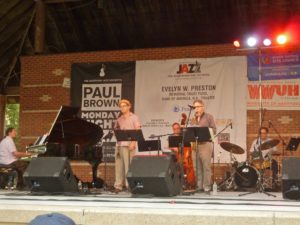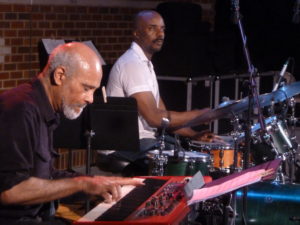by Lisa Chase
The final evening of Monday Night Jazz’s six-week series showcased the genre’s almost limitless variety and its continuous reinvention. Saxophonist Allen Lowe and his quartet started off with a series of original compositions showcasing Aaron Johnson on clarinet, Louis Porter at the piano, Kevin Ray plucking the bass and drummer Ben Bilello. Johnson’s sublime clarinet evoked the swinging Jazz Age, set against Bilello alternating subtle and aggressive touch, while Porter attacked the piano with a visceral force and bassist Ray’s masterful hands plucked a walking bass line. Trumpeter Haneef Nelson and trombonist Matt De Leon joined the band for “Fables of Fascism,” Lowe’s harmonically complex commentary on the violence of Charlottsville. The opening minor chords seemed to signal foreboding and a cautionary lesson about the dangers of white authoritarianism, with Nelson’s soaring lament leading the call before De Leon and Johnson picked up the refrain by turns. Porter set up a rocking beat on the piano and took the piece to a complex harmonic finish underscored by a tense base line and Bilello’s driving drum beat. For an upbeat encore, the quartet, along with Nelson and De Leon, played an upbeat “Lester Leaps In” set to a swinging dance beat. In the midst of conflict, jazz reminds us, there’s always time to dance.
During the intermission, Maurice Robertson announced saxophonist GB Sneed as the Hartford Jazz Society Emerging Artist winner, selected from the four finalists who’ve performed for the Monday Night Jazz audience. Sneed, who picked up the saxophone just four years ago, will appear in a 15-minute set on this year’s River Cruise, scheduled for September 9 (tickets on sale at http://hartfordjazzsociety.com/jazz-river-cruise/).
Darius Jones Shades of Black closed out the evening with a two-set performance of unparalleled musical improvisation and conceptualization built on the interplay of Jones’ alto saxophone and Sam Newsome’s soprano sax. With Cooper Moore on the electric organ and Chad Taylor at the drum kit, the performance was an improvisational feast for the ears – and the soul. With Taylor issuing a rapid-fire beat on the drums and Moore issuing a panoply of sounds from his synthesized organ, Jones and and Newsome explored the full range of their saxophones and surprised the audience with heretofore unheard tones. Jones and Newsome alternated between melodic, lilting notes and low, crushing dissonance, while Moore’s electric organ undercurrent provided a synthesized calm. On their third piece in the set, Jones and Newsome struck a melodic, slow duet to set up Moore’s rich organ solo before taking back the melody on the alto-soprano saxes. The band’s second set launched with Taylor’s rousing drum solo making judicious use of the snares, before handing the spotlight to Moore, who seemed to transform his organ into an organic being. The piece became an improvisational showpiece, as Jones vocalized into the bell of his saxophone and Newsome played his mouthpiece as an independent instrument. Underneath this improvisational dissonance, the electric organ once again offered a soothing musical counterpoint and Taylor’s drum line became meditative and reassuring. The effect was a testament to jazz’s unlimited musical shades, and the genre’s ability to meld dissonance and consonance for a soulful and cathartic result.






